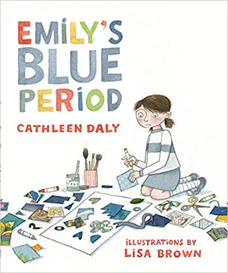Emily’s Blue Period

Recommended Age Range: 1st grade through 4th grade.
Publisher's Summary:
Emily wants to be an artist. She likes painting and loves the way artists like Pablo Picasso mixed things up. Emily’s life is a little mixed up right now. Her dad doesn’t live at home anymore, and it feels like everything around her is changing. “When Picasso was sad for a while,” says Emily, “he only painted in blue. And now I am in my blue period.” It might last quite some time.

Dr. Annie's Takeaways
Recommended for: This is a funny, touching book that portrays a creative way for children to mourn and make peace with having a family that spans multiple homes. This book is best read with children after divorce has already been explained and a separation initiated. This book is also a good fit for therapists who want to engage their clients with divorced parents in a relevant therapeutic art project–either related to a “blue period” or a collage.
Would a child like it? Children who can sit through a longer story would probably like it, particularly if they are interested in art. I think this book would best be paired with a relevant craft project. This is the rare book on divorce that’s a bit light-hearted and funny, which could be very welcome to a child steeped in heavy divorce-related feelings.
Evidence-Based Practices:
Emotional Processing
Tone: Funny, playful, sweet
Story Quality: It’s a charming, not-at-all cloying story, and there’s sophistication in the way the author uses art themes to convey emotional themes (e.g., Picasso “liked to mix things up…Lately Emily’s family is mixed up. She doesn’t like this.”) It shows rather than tells the importance of art in expressing oneself and working through difficult feelings, and it’s not a book that talks down to kids. It also sets up a great craft project (a “home” collage) that kids and their caregivers will be inspired to do after they read the book. There are aspects of this book that might go over some kids’ heads a bit (mostly the allusions to Picasso’s work, but some of the humor too). I don’t necessarily think that’s always a bad thing–parents will enjoy it–but it might lean slightly further towards being a book parents like than one that kids (especially younger ones) like. I found the ending to be genuinely touching.
Illustrations: Pencil and watercolor drawings that add humor and emotional resonance.
Representation: The family members are White (Emily’s full name is Emily Rose Pinchner). Children of color are pictured in Emily’s art class, but they don’t have any dialogue. Emily has a mom and a dad, and the parents share custody. Emily is at her dad’s on weekends. A house is depicted as the mother’s home and an apartment in a multistory building is labeled as the father’s home.
Psychological Practices: This book models the importance of art as a way for kids to express and process their feelings. It also injects some welcome light humor into a subject that is often humorless, which very well could help children to stay engaged and open up about their own feelings and experiences.
Concerns: There’s a scene in which Emily’s little brother has a meltdown at an IKEA-like store, and the father is depicted losing his patience (“This is ridiculous.”). I think this scene is meant to show how everyone is struggling with the divorce, but I suppose it’s worth mentioning that the dad doesn’t necessarily handle the meltdown optimally.
